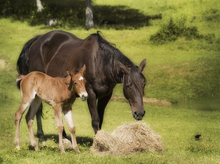According to a Health Brochure from Bayer Animal Health, a healthy foal will grow rapidly, gaining in height, weight and strength almost before your very eyes. From birth to age two, a young horse can achieve 90 percent or more of its full adult size, sometimes putting on as many as 3 pounds per day.

Foal nutrition - For better or worse
Genetics, management and environment play significant roles in determining individual growth patterns in foals, but nutrition influences growth for better or worse.
Genetics, management and environment play significant roles in determining individual growth patterns. Through research, we also know we can influence a foal's growth and development-- for better or worse- -by the nutrition supplied to the foal.
Feeding young horses is a careful balancing act. The interplay between genetics, management, environment and nutrition is complex. While we can do nothing to affect the genetics of an individual, we can affect how those genetics are ultimately expressed.
The nutritional start a foal gets can have a profound effect on its health and soundness for the rest of its life, and growth can be accelerated, but research suggests that a balanced dietary approach, which supports no more than a moderate growth rate, is less likely to cause developmental problems.
Some conditions that have been associated with rapid growth rates include:
- Contracted tendons
- Epiphysitis Angular limb deformities
- Osteochondrosis
One of the foal's first missions in life is to stand and nurse. In doing so, it receives the antibody-rich colostrum that helps protect it from disease. During the first weeks of life, the mare's milk provides everything a rapidly growing foal needs for sustenance. The burden then gradually shifts to other sources.
During lactation, a mare will produce an average of two to three percent of her body weight in milk a day. But in order to do so, she must receive ample feed and water.
Observe the foal's nursing habits. If it suckles for more than 30 minutes at a time, it may not be receiving enough milk. Supplemental feed or milk replacer may be required.
Peak lactation generally occurs during the second and third month of a foal's life. At this time a mare will need almost double the amount of feed she required during her early pregnancy. In addition to extra energy, her diet must include adequate protein, vitamins and minerals to keep from depleting her own body reserves. Increases or decreases in feed should be made gradually over a 7 to 10 day period.
The foals changing diet
As early as 10 to14 days of age, a foal may begin to show an interest in feed. By nibbling and sampling, the youngster learns to eat solid food. Its digestive system quickly adapts to the dietary changes. It is now recognized that coprophagy (eating of feces) is normal in the foal and may lead to “Foal Heat Diarrhea” as the intestinal microflora changes. This diarrhea was previously thought to result from hormonal changes in the milk but has been observed to occur with orphaned foals that have no exposure to maternal hormones.
At eight to 10 weeks of age, mare's milk alone may not adequately meet the foal's nutritional needs, depending on the desired growth rate an owner wants for a foal. In order to achieve a more rapid rate of gain, high-quality grains and forage should be added to the foal's diet.
It is essential the ration be properly balanced for vitamins and minerals. Deficits, excesses or imbalances of calcium, phosphorous, copper, zinc, selenium and vitamin E are of particular concern in the growing foal. Improper amounts or ratios can lead to skeletal problems.
As the foal's dietary requirements shift from milk to feed and forage, your role in providing the proper nutrition gains in importance. Here are some guidelines to help you meet the young horse's needs:< p/>
Foal feeding guidelines:
- Provide high-quality roughage (hay and pasture) free choice.
- Supplement with a high-quality, properly-balanced grain concentrate at weaning, or earlier if more rapid rates of gain are desired.
- Start by feeding one percent of a foal's body weight per day, (i.e. one pound of feed for each 100 pounds of body weight), or one pound of feed per month of age.
- Weigh and adjust the feed ration based on growth and fitness. A weight tape can help you approximate a foal's size.
- Foals have small stomach’s, so divide the daily ration into two to three feedings.
- Make sure feeds contain the proper balance of vitamins, minerals, energy and protein.
- Use a creep feeder or feed the foal separate from the mare so it can eat its own ration. Try to avoid group creep feeding situations.
- Remove uneaten portions between feedings.
- Do not overfeed. Overweight foals are more prone to developmental orthopedic disease (DOD).
- Provide unlimited fresh, clean water.
- Provide opportunity for abundant exercise.
Weaning foals:
Foals are commonly weaned at four to six months of age. Beginning about the third month, the mare's milk supply gradually declines and a natural weaning process begins.
To prepare the foal for complete weaning, its ration should be increased over a two to three week period to make up for the nutrients being lost in the diminishing milk supply. The mare's grain should be reduced and/or gradually eliminated to further limit milk production.
Once the foal is no longer nursing, a 500 to 600 pound weanling should be eating between approximately two to three percent of its body weight in feed and forage a day.
For more information, contact your veterinarian.
Read more about Foal Health
